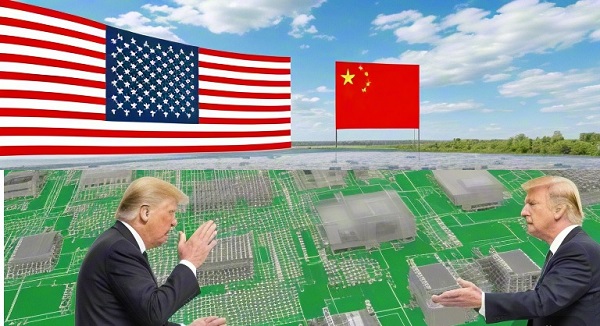The Impact of Trump's Tariff Policy on Chinese PCB Industry and Countermeasures
Keywords: Trump's Tariff Policy, PCB, Countermeasures
Abstract
This article analyzes the impact of the tariff policies implemented by the Trump administration on China since 2018 on the global printed circuit board (PCB) industry chain, particularly on the Chinese PCB industry. Research has found that tariff policies pose challenges to Chinese PCB industry through three dimensions: directly increasing export costs, indirectly reshaping the global supply chain, and accelerating technological competition. However, they also force Chinese companies to accelerate technological upgrades and market diversification. The article concludes with policy recommendations and corporate response strategies.

1、 Research Background
The core content of Trump's tariff policy
In July 2018, the Trump administration announced a 25% tariff on $34 billion worth of Chinese goods, including electronic components, communication equipment, and other products closely related to the PCB industry, based on the results of the "301 investigation" (Office of the United States Trade Representative, 2018). The subsequent tariff list will gradually expand to $200 billion worth of goods, and upstream raw materials for PCBs (such as copper-clad laminates) and some mid to low end PCB products will be included in the scope of taxation.
The Global Status of Chinese PCB Industry
China is the world's largest PCB producer and exporter, accounting for 53.8% of the global output value in 2020 (Prismark data). PCB, as the "skeleton" of electronic products, is widely used in consumer electronics, communication equipment, automotive electronics and other fields, and its industrial chain is deeply embedded in the global division of labor system.
2、 The Direct Impact of Trump's Tariffs on Chinese PCB Industry
Rising export costs and order transfer
Direct tariff cost: The 25% tariff rate has led to a decrease in the price competitiveness of PCB products exported from China to the United States. For example, in 2019, Chinese PCB exports to the United States decreased by 12.3% year-on-year (according to data from the General Administration of Customs of China).
Order transfer effect: Some American purchasers transfer their orders to Southeast Asia (such as Thailand, Vietnam) and Taiwan, China. For example, Pengding Holdings (Zhending) in Apple's supply chain is accelerating the establishment of factories in India to avoid tariff risks.
Supply chain disruption and inventory pressure
Fluctuations in raw material costs: Upstream materials such as copper-clad laminates (CCL) are subject to tariffs, leading to a "double cost squeeze" for Chinese PCB companies.
Inventory backlog risk: During the peak period of the 2018-2019 China US trade friction, the average inventory turnover days of Chinese PCB companies increased from 45 days to 58 days (Wind data).
3、 Indirect Impacts and Structural Challenges
Global supply chain restructuring accelerates
The rise of "China+1" strategy: American customers require suppliers to establish backup capacity outside Chinese Mainland. For example, Shennan Circuit invested and built factories in Malaysia, and some Chinese PCB enterprises expanded production capacity in Taiwan, China.
Regional production trend: The demand for local PCB production capacity in North America is increasing, but due to a shortage of skilled workers and environmental costs, it is difficult to replace Chinese supply in the short term.
Technological competition and the risk of being stuck
Restrictions on high-end products: The US export controls on Chinese 5G related PCBs (such as high-frequency high-speed boards) have hindered the technological upgrades of downstream companies such as Huawei and ZTE.
Equipment and material dependence: Key equipment used by Chinese PCB companies (such as laser drilling machines) and high-end resins still rely on imports, and tariffs exacerbate supply chain security risks.
4、 Response Strategies for Chinese PCB industry
Adaptive adjustment at the enterprise level
Market diversification: Expand into European, Japanese, Korean, and domestic markets. For example, Dongshan Precision's exports to Europe increased by 23% in 2021, and the proportion of PCB orders for new energy vehicles increased to 18%.
Technology upgrading: increase R&D investment and make breakthroughs in high-end fields such as high-density interconnection (HDI) and IC substrate. In 2022, the market share of Chinese domestic enterprises in IC carrier boards will increase from 3% in 2018 to 9%.
Policy support and industrial synergy
Tax incentives and subsidies: The government has increased the deduction ratio for R&D expenses of PCB enterprises to 100%, and some regions provide subsidies for imported substitute materials.
Vertical integration of industrial chain: Encourage the integrated layout of copper-clad laminates PCB electronic terminals, such as the collaborative innovation between Shengyi Technology and Fangzheng Technology.
5、 Conclusion and Prospect
Although Trump's tariff policy has caused short-term impact on Chinese PCB industry, in the long run, it has actually accelerated the globalization layout and technological self-reliance process of Chinese enterprises. In the future, with the deepening of RCEP regional cooperation and the promotion of the "dual circulation" strategy, Chinese PCB industry is expected to achieve greater breakthroughs in the high-end manufacturing field. However, geopolitical risks and technological barriers remain core challenges that require sustained attention.
References
Office of the United States Trade Representative (USTR). (2018). Section 301 Investigation Report
Prismark. (2021). Global PCB Industry Annual Report
General Administration of Customs of China (2019-2021). Import and export commodity trade statistics
Annual Financial Reports of Shennan Circuit and Shanghai Electric Power Co., Ltd. (2018-2022)




